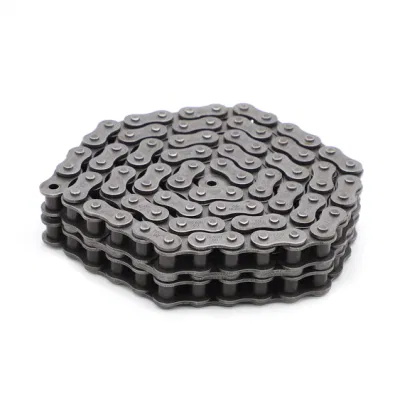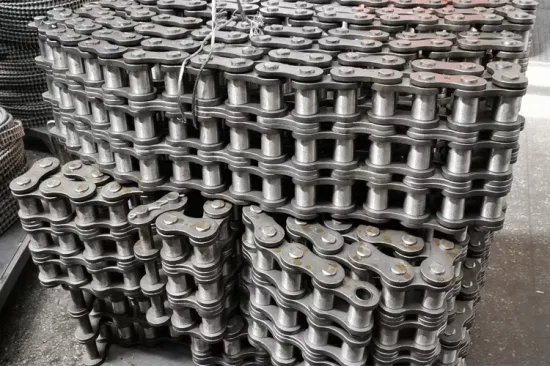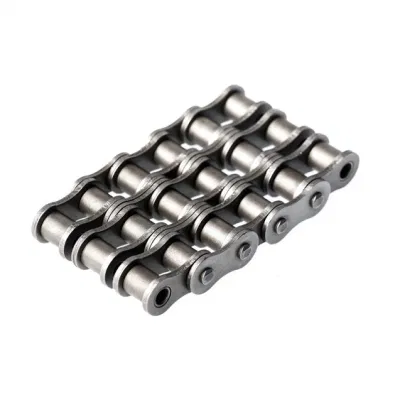Product Description
A Series Short Pitch Precision Triplex Roller Chains & Bush Chains
| ISO/ANSI/ DIN Chain No. |
Chain No. | Pitch P mm |
Roller diameter
d1max |
Width between inner plates b1min mm |
Pin diameter
d2max |
Pin length | Inner plate depth h2max mm |
Plate thickness Tmax mm |
Transverse pitch Pt |
Tensile strength
Qmin |
Average tensile strength Q0 kN |
Weigth per meter q kg/m |
|
| Lmax mm |
Lcmax mm |
||||||||||||
| 160-3 | 32A-3 | 50.800 | 28.58 | 31.55 | 14.27 | 181.8 | 186.6 | 47.80 | 6.40 | 58.55 | 680.4/154636 | 800.7 | 30.02 |
ROLLER CHAIN
Roller chain or bush roller chain is the type of chain drive most commonly used for transmission of mechanical power on many kinds of domestic, industrial and agricultural machinery, including conveyors, wire- and tube-drawing machines, printing presses, cars, motorcycles, and bicycles. It consists of a series of short cylindrical rollers held together by side links. It is driven by a toothed wheel called a sprocket. It is a simple, reliable, and efficient means of power transmission.
CHAIN STRENGTH
The most common measure of roller chain’s strength is tensile strength. Tensile strength represents how much load a chain can withstand under a one-time load before breaking. Just as important as tensile strength is a chain’s fatigue strength. The critical factors in a chain’s fatigue strength is the quality of steel used to manufacture the chain, the heat treatment of the chain components, the quality of the pitch hole fabrication of the linkplates, and the type of shot plus the intensity of shot peen coverage on the linkplates. Other factors can include the thickness of the linkplates and the design (contour) of the linkplates. The rule of thumb for roller chain operating on a continuous drive is for the chain load to not exceed a mere 1/6 or 1/9 of the chain’s tensile strength, depending on the type of master links used (press-fit vs. slip-fit)[citation needed]. Roller chains operating on a continuous drive beyond these thresholds can and typically do fail prematurely via linkplate fatigue failure.
The standard minimum ultimate strength of the ANSI 29.1 steel chain is 12,500 x (pitch, in inches)2. X-ring and O-Ring chains greatly decrease wear by means of internal lubricants, increasing chain life. The internal lubrication is inserted by means of a vacuum when riveting the chain together.
CHAIN STHangZhouRDS
Standards organizations (such as ANSI and ISO) maintain standards for design, dimensions, and interchangeability of transmission chains. For example, the following Table shows data from ANSI standard B29.1-2011 (Precision Power Transmission Roller Chains, Attachments, and Sprockets) developed by the American Society of Mechanical Engineers (ASME). See the references[8][9][10] for additional information.
ASME/ANSI B29.1-2011 Roller Chain Standard SizesSizePitchMaximum Roller DiameterMinimum Ultimate Tensile StrengthMeasuring Load25
| ASME/ANSI B29.1-2011 Roller Chain Standard Sizes | ||||
| Size | Pitch | Maximum Roller Diameter | Minimum Ultimate Tensile Strength | Measuring Load |
|---|---|---|---|---|
| 25 | 0.250 in (6.35 mm) | 0.130 in (3.30 mm) | 780 lb (350 kg) | 18 lb (8.2 kg) |
| 35 | 0.375 in (9.53 mm) | 0.200 in (5.08 mm) | 1,760 lb (800 kg) | 18 lb (8.2 kg) |
| 41 | 0.500 in (12.70 mm) | 0.306 in (7.77 mm) | 1,500 lb (680 kg) | 18 lb (8.2 kg) |
| 40 | 0.500 in (12.70 mm) | 0.312 in (7.92 mm) | 3,125 lb (1,417 kg) | 31 lb (14 kg) |
| 50 | 0.625 in (15.88 mm) | 0.400 in (10.16 mm) | 4,880 lb (2,210 kg) | 49 lb (22 kg) |
| 60 | 0.750 in (19.05 mm) | 0.469 in (11.91 mm) | 7,030 lb (3,190 kg) | 70 lb (32 kg) |
| 80 | 1.000 in (25.40 mm) | 0.625 in (15.88 mm) | 12,500 lb (5,700 kg) | 125 lb (57 kg) |
| 100 | 1.250 in (31.75 mm) | 0.750 in (19.05 mm) | 19,531 lb (8,859 kg) | 195 lb (88 kg) |
| 120 | 1.500 in (38.10 mm) | 0.875 in (22.23 mm) | 28,125 lb (12,757 kg) | 281 lb (127 kg) |
| 140 | 1.750 in (44.45 mm) | 1.000 in (25.40 mm) | 38,280 lb (17,360 kg) | 383 lb (174 kg) |
| 160 | 2.000 in (50.80 mm) | 1.125 in (28.58 mm) | 50,000 lb (23,000 kg) | 500 lb (230 kg) |
| 180 | 2.250 in (57.15 mm) | 1.460 in (37.08 mm) | 63,280 lb (28,700 kg) | 633 lb (287 kg) |
| 200 | 2.500 in (63.50 mm) | 1.562 in (39.67 mm) | 78,175 lb (35,460 kg) | 781 lb (354 kg) |
| 240 | 3.000 in (76.20 mm) | 1.875 in (47.63 mm) | 112,500 lb (51,000 kg) | 1,000 lb (450 kg |
For mnemonic purposes, below is another presentation of key dimensions from the same standard, expressed in fractions of an inch (which was part of the thinking behind the choice of preferred numbers in the ANSI standard):
| Pitch (inches) | Pitch expressed in eighths |
ANSI standard chain number |
Width (inches) |
|---|---|---|---|
| 1⁄4 | 2⁄8 | 25 | 1⁄8 |
| 3⁄8 | 3⁄8 | 35 | 3⁄16 |
| 1⁄2 | 4⁄8 | 41 | 1⁄4 |
| 1⁄2 | 4⁄8 | 40 | 5⁄16 |
| 5⁄8 | 5⁄8 | 50 | 3⁄8 |
| 3⁄4 | 6⁄8 | 60 | 1⁄2 |
| 1 | 8⁄8 | 80 | 5⁄8 |
Notes:
1. The pitch is the distance between roller centers. The width is the distance between the link plates (i.e. slightly more than the roller width to allow for clearance).
2. The right-hand digit of the standard denotes 0 = normal chain, 1 = lightweight chain, 5 = rollerless bushing chain.
3. The left-hand digit denotes the number of eighths of an inch that make up the pitch.
4. An “H” following the standard number denotes heavyweight chain. A hyphenated number following the standard number denotes double-strand (2), triple-strand (3), and so on. Thus 60H-3 denotes number 60 heavyweight triple-strand chain.
A typical bicycle chain (for derailleur gears) uses narrow 1⁄2-inch-pitch chain. The width of the chain is variable, and does not affect the load capacity. The more sprockets at the rear wheel (historically 3-6, nowadays 7-12 sprockets), the narrower the chain. Chains are sold according to the number of speeds they are designed to work with, for example, “10 speed chain”. Hub gear or single speed bicycles use 1/2″ x 1/8″ chains, where 1/8″ refers to the maximum thickness of a sprocket that can be used with the chain.
Typically chains with parallel shaped links have an even number of links, with each narrow link followed by a broad one. Chains built up with a uniform type of link, narrow at 1 and broad at the other end, can be made with an odd number of links, which can be an advantage to adapt to a special chainwheel-distance; on the other side such a chain tends to be not so strong.
Roller chains made using ISO standard are sometimes called as isochains.
WHY CHOOSE US
The 219 sets of advanced automatic production equipment provide guarantees for high product quality. The 167 engineers and technicians with senior professional titles can design and develop products to meet the exact demands of customers, and OEM customizations are also available with us. Our sound global service network can provide customers with timely after-sales technical services.
We are not just a manufacturer and supplier, but also an industry consultant. We work pro-actively with you to offer expert advice and product recommendations in order to end up with a most cost effective product available for your specific application. The clients we serve CHINAMFG range from end users to distributors and OEMs. Our OEM replacements can be substituted wherever necessary and suitable for both repair and new assemblies.
Our Company Certifications
Safe Package and Shipment
Q:Why choose us ?
A. we are a manufacturer, we have manufactured valve for over 20 years .
B. Reliable Quality Assurance System;
C. Cutting-Edge Computer-Controlled CNC Machines;
D. Bespoke Solutions from Highly Experienced Specialists;
E. Customization and OEM Available for Specific Application;
F. Extensive Inventory of Spare Parts and Accessories;
G. Well-Developed CHINAMFG Marketing Network;
H. Efficient After-Sale Service System
Q. what is your payment term?
A: 30% TT deposit, 70% balance T/T before shipping.
Q:Can we print our logo on your products?
A: yes, we offer OEM/ODM service, we support the customized logo, size, package,etc.
Q: Can you make chains according to my CAD drawings?
A: Yes. Besides the regular standard chains, we produce non-standard and custom-design products to meet the specific technical requirements. In reality, a sizable portion of our production capacity is assigned to make non-standard products.
Q: what is your main market?
A: North America, South America, Eastern Europe, Western Europe, Southeast Asia, Africa, Oceania, Mid East, Eastern Asia,
Q: Can I get samples from your factory?
A: Yes, Samples can be provided.
Q: If products have some quality problem, how would you deal with?
A: We will responsible for all the quality problems.
/* January 22, 2571 19:08:37 */!function(){function s(e,r){var a,o={};try{e&&e.split(“,”).forEach(function(e,t){e&&(a=e.match(/(.*?):(.*)$/))&&1
| Standard or Nonstandard: | Standard |
|---|---|
| Application: | Textile Machinery, Garment Machinery, Conveyer Equipment, Packaging Machinery, Electric Cars, Motorcycle, Food Machinery, Mining Equipment, Agricultural Machinery, Car, Textile Machinery, Garment Machinery |
| Surface Treatment: | Polishing |
| Structure: | Roller Chain |
| Material: | Alloy |
| Type: | Derrick, Bush Chain |
| Samples: |
US$ 0/Meter
1 Meter(Min.Order) | |
|---|
| Customization: |
Available
| Customized Request |
|---|

What are the benefits of using a plastic bush chain?
Plastic bush chains offer several advantages in various industrial applications. Here are some benefits of using a plastic bush chain:
1. Corrosion Resistance: Plastic bush chains are highly resistant to corrosion, making them ideal for use in humid or corrosive environments. Unlike metal chains, plastic chains do not rust or deteriorate when exposed to moisture, chemicals, or certain harsh conditions.
2. Lightweight: Plastic bush chains are significantly lighter than their metal counterparts. This lightweight nature reduces the overall weight of the system, making it easier to handle and operate. It also minimizes the load on supporting structures and reduces energy consumption.
3. Low Noise and Vibration: Plastic bush chains produce minimal noise and vibration during operation. Their smooth and quiet operation is beneficial in applications where noise reduction is required, such as in conveyor systems or assembly lines located in noise-sensitive environments.
4. Self-Lubrication: Some plastic bush chains are designed with built-in self-lubricating properties. These chains incorporate lubricating additives or solid lubricants within the plastic material, reducing the need for external lubrication. Self-lubricating plastic bush chains result in reduced maintenance requirements and prolonged chain life.
5. Chemical Resistance: Plastic bush chains exhibit excellent resistance to various chemicals, including oils, solvents, acids, and alkalis. This chemical resistance allows them to maintain their performance and structural integrity even in environments where exposure to chemicals is common.
6. Design Flexibility: Plastic bush chains offer design flexibility, allowing for customization to meet specific application requirements. They can be manufactured in various shapes, sizes, and configurations to accommodate different load capacities, speeds, and operating conditions.
7. Reduced Wear on Equipment: Plastic bush chains have lower friction coefficients compared to metal chains. This reduced friction minimizes wear on the sprockets and other mating components, extending the service life of the entire system and reducing maintenance costs.
8. Electrical Insulation: Plastic bush chains have excellent electrical insulation properties, making them suitable for applications where electrical conductivity needs to be avoided. They can be used in electrical or electronic assembly lines or environments where static electricity control is necessary.
These benefits make plastic bush chains a viable alternative to traditional metal chains in various industries, including food processing, packaging, pharmaceuticals, electronics, and many others.

Can a bush chain be repaired or does it need to be replaced entirely?
When a bush chain is damaged or worn out, the extent of the damage will determine whether it can be repaired or needs to be replaced entirely. Here are the considerations:
1. Minor Damage: In some cases, minor damage to a bush chain can be repaired. This includes issues such as a few broken or worn-out bushings or pins. These components can be replaced individually without replacing the entire chain.
2. Extensive Damage: If the bush chain has extensive damage, such as multiple broken links, severe wear on multiple components, or damaged sprockets, it may be more cost-effective and efficient to replace the entire chain. Repairing such extensive damage can be time-consuming and may not guarantee the chain’s optimal performance.
3. Chain Length: The length of the chain also plays a role in determining whether it can be repaired. If the damaged section is localized and doesn’t affect the overall length significantly, it may be possible to repair or replace only the affected portion.
4. Age and Condition: The age and overall condition of the bush chain should also be considered. If the chain is already worn out, has undergone multiple repairs, or is nearing the end of its service life, it is generally recommended to replace it entirely to ensure reliable operation.
5. Cost Considerations: Finally, the cost of repair versus replacement should be evaluated. In some cases, the cost of repairs, including labor and replacement parts, may exceed the cost of a new chain. In such instances, it is more economical to replace the chain.
Ultimately, the decision to repair or replace a bush chain depends on the extent of the damage, the chain’s overall condition, and cost considerations. It is advisable to consult with a qualified professional or the chain manufacturer for an accurate assessment and recommendation.

How does a bush chain differ from other types of chains?
A bush chain, also known as a bush roller chain or bushing chain, differs from other types of chains in its construction and design. Here are the key ways in which a bush chain differs:
1. Bushing Design: The main distinguishing feature of a bush chain is the presence of bushings or sleeves between the inner and outer links. These bushings serve as bearings that reduce friction and wear between the chain components, resulting in smoother operation and increased chain life.
2. Simplex, Duplex, and Triplex Configurations: Bush chains are available in different configurations, including simplex, duplex, and triplex. These configurations refer to the number of strands of chain running parallel to each other. This allows for increased load capacity and higher torque transmission in the chain system.
3. Link Plate Design: The link plates in a bush chain are typically thicker and heavier compared to other types of chains. This design provides enhanced strength and durability, allowing the chain to withstand heavy loads and resist elongation under tension.
4. Precision Bushing Fit: The bushings in a bush chain have a precise fit with the pins, which ensures proper alignment and smooth rotation. This reduces friction, minimizes wear, and improves the overall efficiency of the chain system.
5. Lubrication Requirements: Bush chains usually require regular lubrication to maintain optimal performance and reduce friction between the components. Lubrication helps prevent wear and corrosion, ensuring the longevity of the chain.
6. Wide Range of Applications: Bush chains are versatile and find applications in various industrial settings, including machinery, automotive systems, agriculture, material handling, mining, and more. Their robust construction and ability to handle high loads make them suitable for demanding applications.
Overall, the inclusion of bushings, the configuration options, and the design characteristics of bush chains distinguish them from other types of chains. Their unique features make them ideal for applications that require durability, high load capacity, and reduced friction for reliable power transmission.


editor by CX 2024-04-16
